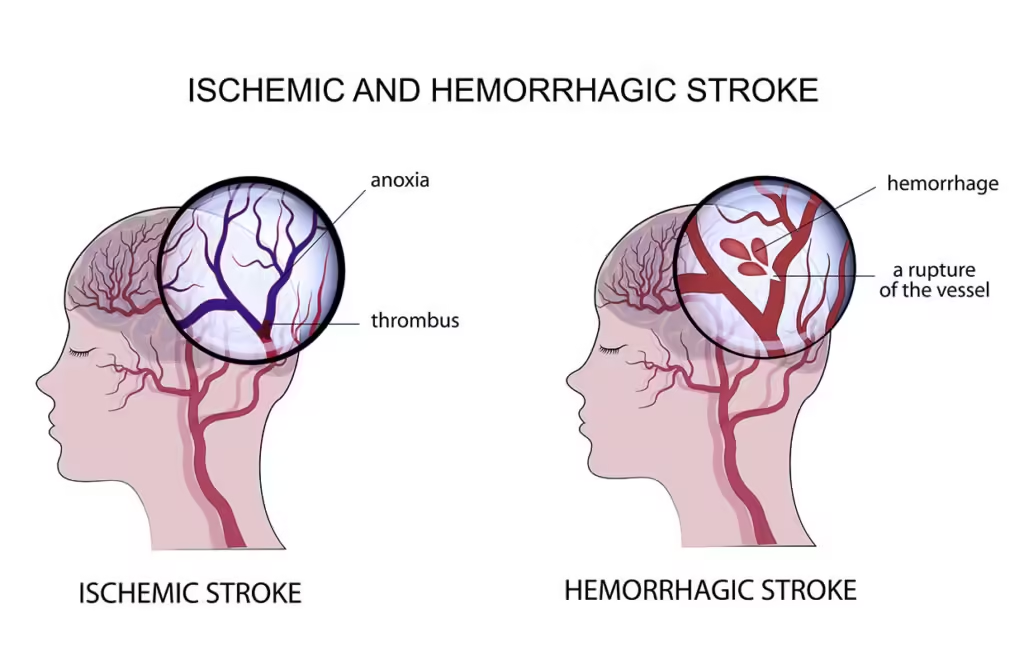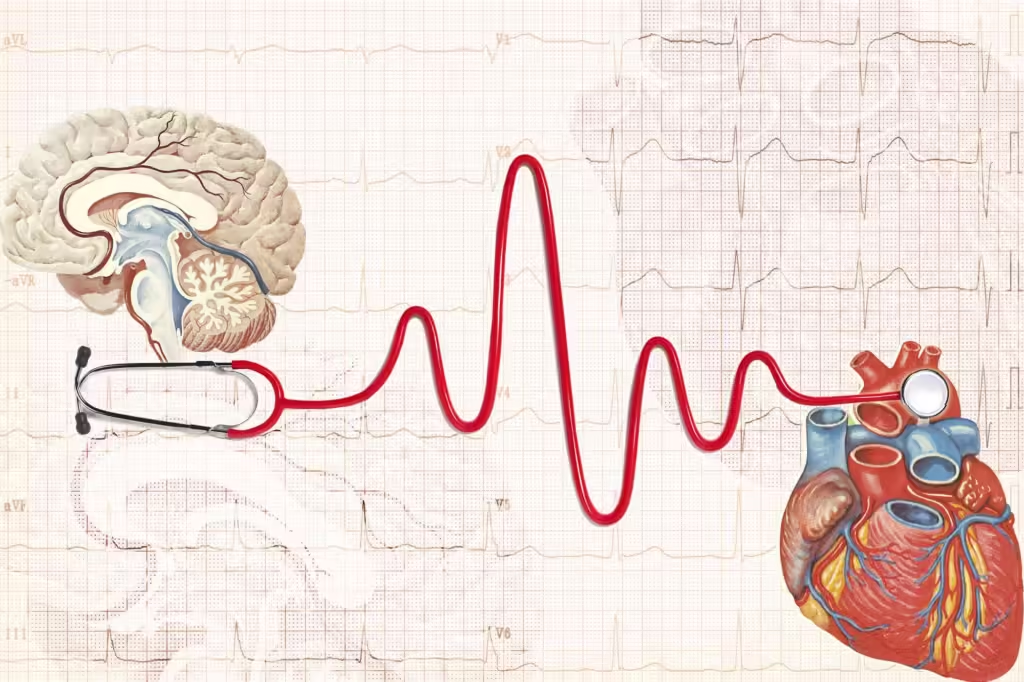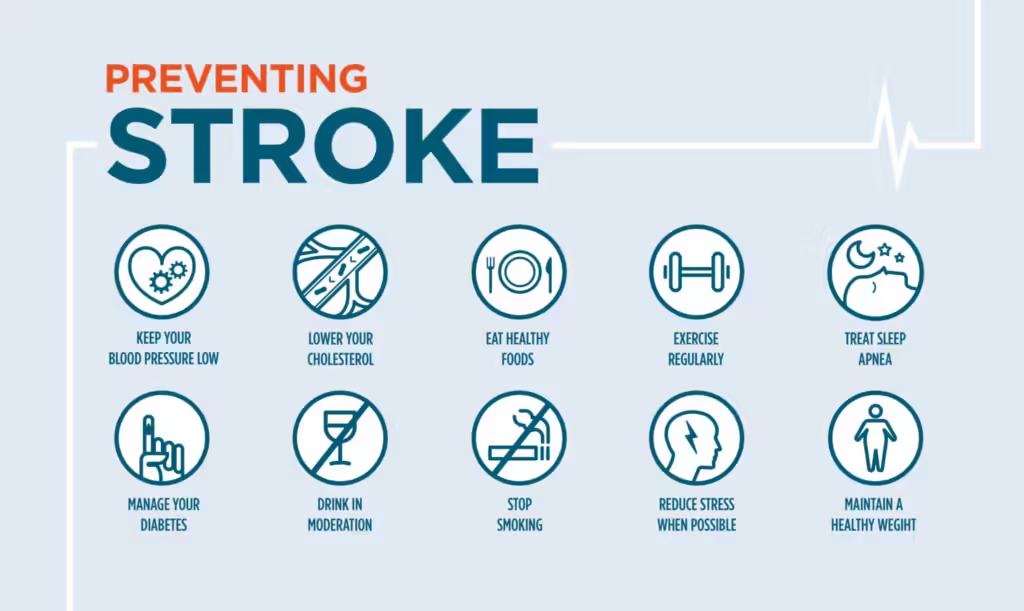Definition of Stroke
A stroke is a condition characterized by brain damage with sudden neurological deficits, presenting with focal rather than diffuse symptoms. These symptoms typically persist for more than 24 hours or result in death within 24 hours, and the underlying cause is spontaneous vascular damage (excluding traumatic brain injury).
Nguyên nhân
Stroke is categorized into two main types based on etiology:
Ischemic stroke/cerebral infarction/ischemic stroke: This occurs when a blood vessel is obstructed either by a local cause or embolism, leading to insufficient blood supply and necrosis in the brain region served by that artery.

Intracranial hemorrhage (IH):
- Intracerebral hemorrhage (ICH): This occurs when blood escapes from the vessel wall into the brain parenchyma.
- Subarachnoid hemorrhage (SAH): Accounting for approximately 5% of intracranial hemorrhages, this type results from the rupture of an arterial aneurysm or non-aneurysmal causes.
Symptoms of Stroke
Headache: In stroke, headaches typically occur suddenly, with severity varying depending on the clinical subtype. Moreover, a severe “thunderclap” headache, accompanied by nausea, vomiting, neck stiffness, and meningeal signs, suggests subarachnoid hemorrhage.
Chóng mặt Dizziness in stroke is often due to central vestibular dysfunction caused by damage to the cerebellum or brainstem.
Visual disturbances: Common manifestations include vision loss, visual field defects, and double vision.

Additionally, language disorders may occur, where patients experience an inability to produce speech (Broca’s area damage) or a failure to comprehend speech (Wernicke’s area damage).
Moreover, sensory disturbances often present as numbness or loss of sensation, typically progressing from the distal to the proximal limbs.
Hemiparesis and hemiplegia are the most common symptoms, occurring when the damage affects the corticospinal tract (pyramidal system).
Altered consciousness and coma: These occur when the damage or dysfunction involves the reticular activating system or both cerebral hemispheres.
Chẩn đoán
The initial and primary diagnosis of a brain attack is primarily based on clinical presentation: the sudden onset of focal neurological deficits are the two key factors. Consequently, when a sudden clinical presentation with evident focal neurological deficits occurs, the diagnosis of stroke is relatively particular. Additionally, in an emergency setting, clinicians typically choose a CT scan of the brain to exclude hemorrhage and detect early large infarctions in patients with poor collateral circulation.
Laboratory and imaging assessments in stroke diagnosis include:
- Computerised tomography Scan (CT scan): CT scan can detect early intracranial hemorrhage and visualize established infarctions, though they may not reveal early or small infarctions, particularly in the brainstem. It is the first choice in stroke emergencies.
- Magnetic resonance imaging (MRI): MRI provides superior imaging compared to CT scans and offers more detailed information about the characteristics of tissue damage. It can survey multiple planes, is sensitive to damaged tissues, detect large vessel occlusions without contrast agents, and clearly distinguishes between hemorrhage and ischemia.
- Carotid and transcranial Doppler ultrasound: These assess the condition of atherosclerosis, stenosis, and occlusions in the extracranial carotid and vertebral arteries, as well as large intracranial arteries.
- Cardiac assessments: Electrocardiography (ECG) and echocardiography: These are performed on all stroke patients to evaluate cardiac function.
- Other assessments: Routine biochemical and, hematological and selective diagnostic tests rule out other causes and assist in differential diagnosis.
Điều trị
Stroke is a critical condition that poses significant risks, potentially leading to profound mental and physical disabilities. Effective emergency interventions and treatment approaches, such as stroke unit care, intravenous thrombolysis, and mechanical thrombectomy for acute ischemic stroke, have demonstrated substantial benefits for patients.
Rehabilitation and recurrence prevention:
Assessment and initiation of rehabilitation should begin on the first day of stroke onset. This process involves physical therapy, speech therapy, and occupational therapy.
Prevention of recurrence includes:
- Screening for risk factors and identifying the cause.
- Managing risk factors:
- Treating hypertension and diabetes if present.
- Adopting a disease-specific diet: reducing salt and saturated fats, increasing vegetables, and lowering carbohydrate intake for diabetic patients.
- Enhancing physical activity.
- Correcting lipid disorders.
- Screening for and treating sleep apnea if present.
- Quitting smoking, reducing alcohol consumption, and avoiding other stimulants.
Causal prevention treatment:
- Assessing the cause according to the TOAST classification.
- Medication groups for causal treatment:
- Antiplatelet agents: Aspirin/Clopidogrel.
- Lipid-lowering agents: Atorvastatin/Rosuvastatin.
Phòng ngừa
Stroke prevention primarily involves effective control of risk factors:

- Adopting a healthy lifestyle and making lifestyle changes.
- Engaging in regular, moderate physical exercise.
- Managing underlying conditions such as hypertension, diabetes, dyslipidemia, obesity, and other cardiovascular diseases.
- Limiting the intake of stimulants like coffee, tea, and alcohol and quitting smoking.

